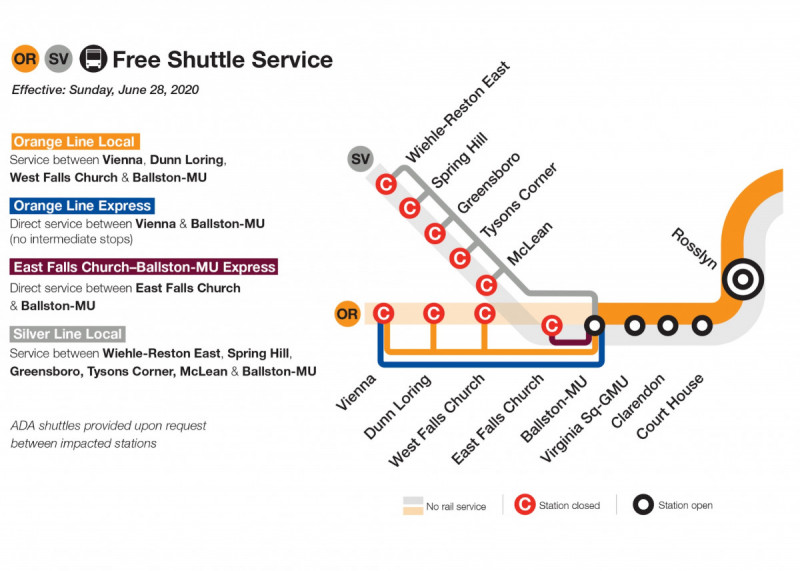Metro plans to reopen the Silver Line and other stations earlier than previously announced

Tracks on the Silver Line by the author.
Six of the nine stations shut down west of Ballston will reopen on August 16, Metro said Wednesday in a press release. Work in two areas, at Wiehle and East Falls Church, will be far-enough along to allow McLean, Tysons Corner, Greensboro, Spring Hill, Wiehle, and West Falls Church to open back up again for riders.
These openings are in addition to the 15 stations that Metro announced would reopen Sunday after they closed due to COVID-19 in March.
Metro closed all stations west of Ballston back on May 23 for two sets of work. The main reason for the closure was the Platform Improvement Project, through which Metro is rehabilitating the platforms at Vienna, Dunn Loring, West Falls Church, and East Falls Church.
Metro and its contractor Kiewitt are replacing granite tile edges and pouring new concrete to fix platforms which had become cracked and deteriorated being out in the elements and lacking maintenance in earlier years.
The secondary reason for the closure revolved around Metro’s need to give Metropolitan Washington Airports Authority contractors time to perform signaling tie-in work at the Wiehle station in preparation for next year’s opening of Phase 2 of the Silver Line.
An image of stations scheduled for summer shutdown. Image by WMATA.
Earlier iterations of Metro plans proposed several months of weekend shutdowns at Wiehle, but were later modified to a multi-week shutdown at just Wiehle. In the end, staffing issues and coronavirus fears in the agency’s rail operations control center helped drive the decision to close the Silver Line stations which significantly simplified rail operations when combined with the platform work.
Keeping the Silver Line open (even to just Spring Hill) with the Orange Line running to West Falls Church would have required rail controllers to perform many repetitive tasks that they don’t ordinarily need to:
- At Ballston, every other Orange Line train would have ended service and turned around in order to run back towards New Carrollton. Controllers would have had to go into the software they use, align the switches at the station so those trains could cross from the outbound track to the inbound track, and then reset the switches again for the next train behind.
- At East Falls Church, both Silver and Orange Line trains would have been single-tracking by way of either the inbound or outbound track. Here, controllers would have had to set the switches both at East Falls Church and also the next location trains are able to cross over to the west.
- With West Falls Church open as the western terminus of the Orange Line, rail controllers here would have more switches to control on their computers for trains coming into and leaving the station.
While aligning switches is as simple as using a computer mouse and clicking some boxes on the screen, the controller responsible for doing so would have had to do that all day for each train during the shutdown adding more work to their already-stressful jobs. Metro decided the benefits of a full shutdown were worth it.
Metro says the platform rebuilding work at Vienna, Dunn Loring, and East Falls Church is on schedule and the stations should reopen “around Labor Day.”
Stations closed due to the coronavirus reopening this Sunday
The fifteen rail stations which Metro closed on March 26 will be reopening on Sunday. These stations were closed to “conserve critical cleaning supplies at the early stages of its pandemic response,” according to WMATA.
Shuttle buses will also begin making stops at East Falls Church, McLean, and Greensboro which had previously been skipped over.
All rail stations reopening on Sunday are: Federal Center SW, Federal Triangle, Mt Vernon Square, Judiciary Square, Archives, Smithsonian, Eisenhower Ave, Virginia Square, Van Dorn St, Clarendon, Cleveland Park, Grosvenor-Strathmore, Cheverly, College Park, and Morgan Blvd.
Station entrances at several stations, which had also been closed in March, will be reopening Sunday as well: Anacostia, Farragut North, Dupont Circle, Metro Center, Ronald Reagan Washington National Airport, U Street, Gallery Place-Chinatown, Friendship Heights, and L’Enfant Plaza.
Bus service gets moved around
Metro also recently announced that bus service is being moved between lines to give more service to busy routes. The agency says it will be adding 136 trips across 14 routes: 54, 70, 92, 30N, 30S, A4, A6, A8, P6, V4, W4, F4, P12, and T18.
In order to increase service on those routes, Metro is suspending four others - the NH2, C14, G2, and M6 - and cutting service on the 22A, 62, D2, E2, H6, U4, and X8.
Metrobus’ reported ridership has been above the capacity number which Metro said allowed for adequate social distancing. Metro said 85,000 daily trips can be taken while maintaining social distancing, however actual Metrobus ridership has hovered between 130,000 and 140,000 trips per day.
On June 7 Metro stopped reporting Metrobus ridership statistics which they say didn’t include “an inherent ‘noise factor’” from the automatic passenger counters. That factor “must be calculated and removed in order to provide accurate ridership counts,” the agency said in an update. The restated Metrobus ridership numbers are expected to be lower when they’re released.
Most Metrobus routes which haven’t been suspended are running reduced schedules during the week. A smaller set of 27 “lifeline” bus routes run on the weekends.
